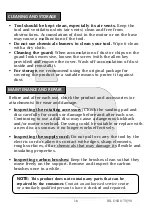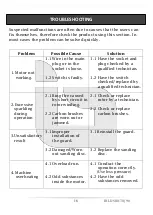
15
The Drywall Sander should always be held with both hands, one
on the trigger switch handle, and other on the side handle.
Adjust the carry straps on the dust bag for operator convenience
and comfort. Adopt the correct posture for the operation.
Let the sanding disc come to full speed before applying it onto
the work.
Switch the machine ON and position the sanding base lightly
against the work surface, and apply just enough pressure to align
the base with the work surface.
Gently apply more pressure to engage the rotating abrasive disc
onto the work surface.
Move the sander across the work surface in long overlapping
sweeps. Apply only enough pressure to keep the abrasive disc flat
against the work surface.
Excessive pressure should be avoided as it can cause swirl marks
and unevenness in the work surface.
Keep the sander in constant motion while the abrasive disc is in
contact with the work surface. Use a steady, sweeping motion,
allowing the rotating abrasive disc to float over the work surface.
Moving the sander erratically or concentrating for too long on one
area can cause swirl marks in the surface.
Once the sanding task has been completed, turn OFF the sander
by releasing the trigger. If the sander has been locked ON, press
down the lock button and trigger to release them, and your tool
will turn OFF. Wait for the base pad to stop rotating before setting
the tool down.
GENERAL OPERATION
IBL DS80-70|90
WARNING!
Do not force the tool or apply excessive pressure,
this may cause damage to the motor. Let the tool do the work.
Always use the side handle. The operator should adopt a
comfortable posture with their feet apart and firmly balanced.
We recommend a maximum operator duty cycle of 10–12
minutes, after which the operator should rest for 5 minutes
before resuming sanding operations.
Refer page no. 6 and 7 for the specific instructions before
operating the tool.
Summary of Contents for DS 80-70
Page 1: ...DRYWALL SANDER DS80 70 90 ...
Page 2: ...1 ...





































